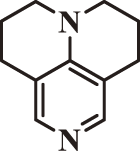-
Minoru Ozeki
Corresponding author
Faculty of Pharmaceutical Sciences, Mukogawa Women’s University, 11–68 Koshien Kyuban-cho, Nishinomiya, Hyogo 663–8179, Japan
-
Mizuki Tsuda
Faculty of Pharmaceutical Sciences, Mukogawa Women’s University, 11–68 Koshien Kyuban-cho, Nishinomiya, Hyogo 663–8179, Japan
-
Serina Yamanouchi
Faculty of Pharmaceutical Sciences, Mukogawa Women’s University, 11–68 Koshien Kyuban-cho, Nishinomiya, Hyogo 663–8179, Japan
-
Momoe Yamakawa
Faculty of Pharmaceutical Sciences, Mukogawa Women’s University, 11–68 Koshien Kyuban-cho, Nishinomiya, Hyogo 663–8179, Japan
-
Kanako Fukuda
Faculty of Pharmaceutical Sciences, Mukogawa Women’s University, 11–68 Koshien Kyuban-cho, Nishinomiya, Hyogo 663–8179, Japan
-
Hirotaka Sasa
Faculty of Pharmaceutical Sciences, Mukogawa Women’s University, 11–68 Koshien Kyuban-cho, Nishinomiya, Hyogo 663–8179, Japan
-
Takuya Matsumoto
Faculty of Pharmaceutical Sciences, Mukogawa Women’s University, 11–68 Koshien Kyuban-cho, Nishinomiya, Hyogo 663–8179, Japan
-
Aya Niki
Faculty of Pharmaceutical Sciences, Mukogawa Women’s University, 11–68 Koshien Kyuban-cho, Nishinomiya, Hyogo 663–8179, Japan
-
Maaya Nobata
Faculty of Pharmaceutical Sciences, Mukogawa Women’s University, 11–68 Koshien Kyuban-cho, Nishinomiya, Hyogo 663–8179, Japan
-
Takashi Shigeta
School of Food and Nutritional Sciences, University of Shizuoka, 52–1 Yada, Suruga-ku, Shizuoka 422–8526, Japan
-
Tetsuya Kajimoto
College of Pharmaceutical Sciences, Ritsumeikan University, 1–1–1 Noji-higashi, Kusatsu, Shiga 525–8577, Japan
-
Kenji Arimitsu
Faculty of Pharmacy, Osaka Ohtani University, 3–11–1 Nishikiori-kita, Tondabayashi, Osaka 584–8540, Japan
-
Shinzo Hosoi
Kyoto Pharmaceutical University, 1 Shichono-cho, Misasagi, Yamashina-ku, Kyoto 607–8414, Japan
-
Hiroki Iwasaki
Kyoto Pharmaceutical University, 1 Shichono-cho, Misasagi, Yamashina-ku, Kyoto 607–8414, Japan
-
Naoto Kojima
Faculty of Pharmaceutical Sciences, Nagasaki International University, 2825–7 Huis Ten Bosch Machi, Sasebo, Nagasaki 859–3298, Japan
-
Ikuo Kawasaki
Corresponding author
Faculty of Pharmaceutical Sciences, Mukogawa Women’s University, 11–68 Koshien Kyuban-cho, Nishinomiya, Hyogo 663–8179, Japan
Supplementary material
2025 Volume 73 Issue 3 Pages 264-267
- Published: March 29, 2025 Received: November 07, 2024 Released on J-STAGE: March 29, 2025 Accepted: January 15, 2025 Advance online publication: - Revised: -
(compatible with EndNote, Reference Manager, ProCite, RefWorks)
(compatible with BibDesk, LaTeX)








